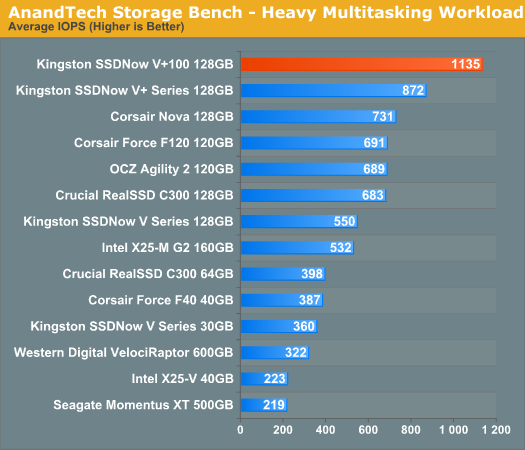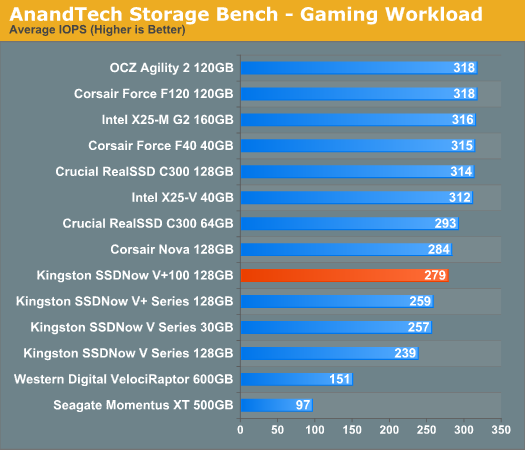Kingston SSDNow V+100 Review
by Anand Lal Shimpi on November 11, 2010 3:05 AM EST- Posted in
- Storage
- SSDs
- Kingston
- SSDNow V+100
AnandTech Storage Bench
To avoid any potential optimizations for industry standard benchmarks and to provide another example of real world performance we've assembled our own storage benchmarks that we've creatively named the AnandTech Storage Bench.
The first in our benchmark suite is a light/typical usage case. The Windows 7 system is loaded with Firefox, Office 2007 and Adobe Reader among other applications. With Firefox we browse web pages like Facebook, AnandTech, Digg and other sites. Outlook is also running and we use it to check emails, create and send a message with a PDF attachment. Adobe Reader is used to view some PDFs. Excel 2007 is used to create a spreadsheet, graphs and save the document. The same goes for Word 2007. We open and step through a presentation in PowerPoint 2007 received as an email attachment before saving it to the desktop. Finally we watch a bit of a Firefly episode in Windows Media Player 11.
There’s some level of multitasking going on here but it’s not unreasonable by any means. Generally the application tasks proceed linearly, with the exception of things like web browsing which may happen in between one of the other tasks.
The recording is played back on all of our drives here today. Remember that we’re isolating disk performance, all we’re doing is playing back every single disk access that happened in that ~5 minute period of usage. The light workload is composed of 37,501 reads and 20,268 writes. Over 30% of the IOs are 4KB, 11% are 16KB, 22% are 32KB and approximately 13% are 64KB in size. Less than 30% of the operations are absolutely sequential in nature. Average queue depth is 6.09 IOs.
The performance results are reported in average I/O Operations per Second (IOPS):

The higher capacity SandForce drives rule the roost here, but the C300, X25-M G2 and V+100 are not too far behind. Despite its age, Intel's X25-M G2 performs very well in our light usage test. The V+100 isn't far behind thanks to its 8.5% improvement over the original V+.
As far as small capacity drives go, the Corsair Force F40 and other similarly sized SandForce drives are the clear winners here. Crucial's 64GB RealSSD C300 is quicker than the X25-V, but no match for the 40GB SF drive.
If there’s a light usage case there’s bound to be a heavy one. In this test we have Microsoft Security Essentials running in the background with real time virus scanning enabled. We also perform a quick scan in the middle of the test. Firefox, Outlook, Excel, Word and Powerpoint are all used the same as they were in the light test. We add Photoshop CS4 to the mix, opening a bunch of 12MP images, editing them, then saving them as highly compressed JPGs for web publishing. Windows 7’s picture viewer is used to view a bunch of pictures on the hard drive. We use 7-zip to create and extract .7z archives. Downloading is also prominently featured in our heavy test; we download large files from the Internet during portions of the benchmark, as well as use uTorrent to grab a couple of torrents. Some of the applications in use are installed during the benchmark, Windows updates are also installed. Towards the end of the test we launch World of Warcraft, play for a few minutes, then delete the folder. This test also takes into account all of the disk accesses that happen while the OS is booting.
The benchmark is 22 minutes long and it consists of 128,895 read operations and 72,411 write operations. Roughly 44% of all IOs were sequential. Approximately 30% of all accesses were 4KB in size, 12% were 16KB in size, 14% were 32KB and 20% were 64KB. Average queue depth was 3.59.

This is another one of those SYSMark-like situations. The old Toshiba controller did just awesome in our heavy multitasking workload and the new update does even better. At 1135 IOPS, the V+100 is 55% faster than the Indilinx based Corsair Nova. Thanks to the incompressible nature of much of the data we're moving around in this benchmark the SandForce drives don't do so well. Although not pictured here, the 256GB C300 would be #2 - still outperformed by the V+100.
The gaming workload is made up of 75,206 read operations and only 4,592 write operations. Only 20% of the accesses are 4KB in size, nearly 40% are 64KB and 20% are 32KB. A whopping 69% of the IOs are sequential, meaning this is predominantly a sequential read benchmark. The average queue depth is 7.76 IOs.

The perplexing nature of the V+100 continues here. While it boasts great sequential read numbers, the smaller and somewhat random accesses drop the V+100 behind the SandForce and Crucial SSDs.










96 Comments
View All Comments
Ezekeel - Thursday, December 9, 2010 - link
That is all you have to do to enable TRIM, yes.However, I was talking about optimizations for an SSD (https://wiki.archlinux.org/index.php/SSD#Tips_for_... http://cptl.org/wp/index.php/2010/03/30/tuning-sol... which you all have to do manually while Windows7 afaik does at least some optimizations automatically if you install it on an SSD, like disabling (Super)PreFetch and indexing. Also partition setup with diskpart under Windows automatically takes care of a proper partition alignment while you still have to do it manually under Linux (http://randomtechoutburst.blogspot.com/2010/03/4k-...
ClagMaster - Monday, November 15, 2010 - link
You are right Mr Shimpi that this is confusing and I got a headache.I am not certain what I am going to get if I order a Kingston Drive. Performance is so diverse and the model nomenclature so similar.
I am going to get a OCZVertex 2 or an Intel X-25 G2 instead. I know what I am getting with these brands.
psyside1 - Sunday, November 21, 2010 - link
Hi Anand and all who read this.
Let me start of by saying that i'm new to SSD tech (noob) and i'm starting to learning but there are some things which where not pointed in the reviews as far as i remember.
Heck, even in this review you said that Inferno is somewhat capped to 50 mb/s if i'm not wrong?
So in short,
Where i live i'm limited to 2 models, one is Patriot Inferno and the Other A-DATA S599 with possibly 50K IOPS firmware, as Newegg and Amazon specs confirm?
Now, does that firmware insure i won't get slowdowns (at some points) like the Inferno model in this review? or there is some more about it. if there is, i really got no idea how is that possible same controller, same build? and heck in most of the test the Vertex 2 is still fastest, even faster then the other drives which now share the 50K IOPS firmware, G.Skill Phoenix pro, Corsair Force etc??
i'm mostly interested in SSD which will have good read/write speeds (4K etc) and to be fast during programs/games installation. I got 6 pcs connected in network so that means alot to me, in short does my needs require higher IOPS firmware or i would not notice any difference in performance during installation of big size programs/games.
Also, is it possible to know what revision you get without actually buying the product? is there any info on the package/sticker or part number? the difference in performance i noticed in some reviews was 2x higher random write (4K) speed on the models with OCZ "exclusive firmware. And as far that point goes i'm totally clueless does it really matter at all, and if its not how that that translate in real world usage?
Please answer i don't want to regret my purchase :(
Thanks and sorry for slight off topic :)
psyside1 - Sunday, November 21, 2010 - link
Sorry for double post there is no edit option, actually Madman007 was asking the same i did on the more appropriate way, my English is bad.
tno - Sunday, May 1, 2011 - link
"Remember that NAND is written to at the page level (4KB), but erased at the block level (512 pages)." I think you meant '512 KB.'Gaucherre - Friday, May 6, 2011 - link
Instead of $259, the Kingston V100+ 96GB is available for $119.99 after rebate from Buy.com. This pricing completely changes the value rating from acceptable to outstanding value! The mail-in rebate is rotating from one online store to another. Last month it was at Newegg.com; right now it's at Buy.com. Next month - who knows? Anyway, the cost per Gigabyte when tested here at Anandtech.com was around $2.70. Now it's $1.25 per Gigabyte, and a 96GB drive is large enough for Windows plus quite a few installed programs and games. Pretty good value. Think I just talked myself into ordering one .......